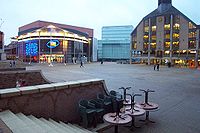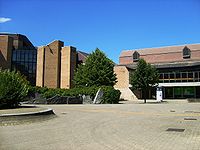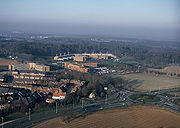
Louvain-la-Neuve
Encyclopedia
| Ottignies-Louvain-la-Neuve | |
|---|---|
 |
|
| Province Provinces of Belgium Belgium is divided into three regions, two of them are subdivided into five provinces each.The division into provinces is fixed by Article 5 of the Belgian Constitution... : |
Walloon Brabant Walloon Brabant Walloon Brabant is a province of Wallonia in Belgium. It borders on the province of Flemish Brabant and the provinces of Liège, Namur and Hainaut . Its capital is Wavre... |
| District: | Wavre |
| Area Area Area is a quantity that expresses the extent of a two-dimensional surface or shape in the plane. Area can be understood as the amount of material with a given thickness that would be necessary to fashion a model of the shape, or the amount of paint necessary to cover the surface with a single coat... : |
32.96 km² |
| Population Population A population is all the organisms that both belong to the same group or species and live in the same geographical area. The area that is used to define a sexual population is such that inter-breeding is possible between any pair within the area and more probable than cross-breeding with individuals... : |
29,521 (2006) |
| Population density Population density Population density is a measurement of population per unit area or unit volume. It is frequently applied to living organisms, and particularly to humans... : |
896 /km² |
 |
|
Louvain-la-Neuve (lu.vɛ̃.la.nœv) is a planned city in the municipality of Ottignies-Louvain-la-Neuve
Ottignies-Louvain-la-Neuve
Ottignies-Louvain-la-Neuve is a Walloon municipality located in the Belgian province of Walloon Brabant. On January 1, 2006 Ottignies-Louvain-la-Neuve had a total population of 29,521. The total area is 32.96 km² which gives a population density of 896 inhabitants per km².The two main towns in the...
, Belgium
Belgium
Belgium , officially the Kingdom of Belgium, is a federal state in Western Europe. It is a founding member of the European Union and hosts the EU's headquarters, and those of several other major international organisations such as NATO.Belgium is also a member of, or affiliated to, many...
, situated 30 km southeast of Brussels
Brussels
Brussels , officially the Brussels Region or Brussels-Capital Region , is the capital of Belgium and the de facto capital of the European Union...
, in the French-speaking part of the country. The city was built to house the Université Catholique de Louvain
Université catholique de Louvain
The Université catholique de Louvain, sometimes known, especially in Belgium, as UCL, is Belgium's largest French-speaking university. It is located in Louvain-la-Neuve and in Brussels...
; following the linguistic quarrels that took place in Belgium during the 1960s
1960s
The 1960s was the decade that started on January 1, 1960, and ended on December 31, 1969. It was the seventh decade of the 20th century.The 1960s term also refers to an era more often called The Sixties, denoting the complex of inter-related cultural and political trends across the globe...
, and Flemish
Flemish people
The Flemings or Flemish are the Dutch-speaking inhabitants of Belgium, where they are mostly found in the northern region of Flanders. They are one of two principal cultural-linguistic groups in Belgium, the other being the French-speaking Walloons...
claims of discrimination at the Catholic University of Leuven
Catholic University of Leuven
The Catholic University of Leuven, or of Louvain, was the largest, oldest and most prominent university in Belgium. The university was founded in 1425 as the University of Leuven by John IV, Duke of Brabant and approved by a Papal bull by Pope Martin V.During France's occupation of Belgium in the...
, the institution was split into the Dutch language Katholieke Universiteit Leuven
Katholieke Universiteit Leuven
The Katholieke Universiteit Leuven is a Dutch-speaking university in Flanders, Belgium.It is located at the centre of the historic town of Leuven, and is a prominent part of the city, home to the university since 1425...
which remained in Leuven, and the Université Catholique de Louvain.
To a great extent, it still lives following the rhythms of the university that is its raison d'être. However, with the recent construction of L'Esplanade shopping complex, the Aula Magna exhibition centre and auditorium, as well as a large cinema complex, it is beginning to grow beyond its academic roots.
Louvain-la-Neuve is an example of the "automobile under" type of New Pedestrianism
New pedestrianism
New Pedestrianism is a more idealistic variation of New Urbanism in urban planning theory, founded in 1999 by Michael E. Arth, an American artist, urban/home/landscape designer, futurist, and author...
.
History

Province of Brabant
Brabant was a province of the United Kingdom of the Netherlands from 1815 until 1830 and a province of Belgium from 1830 until 1995, when it was split into the Dutch-speaking Flemish Brabant, the French-speaking Walloon Brabant and the bilingual Brussels-Capital Region.-United Kingdom of the...
. They bought a 9 square kilometre plot of beetroot farmland, which became the site from which the new city would arise. Construction started on 20 January 1969.
The first inhabitants arrived in 1972. At this time, there were only around 600 permanent residents of the city, who were joined during the day by some students of Applied Sciences, the first faculty to open. With the completion of university buildings and the ongoing residential development, the city experienced rapid growth, with 10,477 inhabitants recorded in 1981. The final goal is to reach 30 000 inhabitants, in addition to the 15 000 thousand students living in town during the academic year.
The town was created with the sole purpose of hosting the Université de Louvain
Université catholique de Louvain
The Université catholique de Louvain, sometimes known, especially in Belgium, as UCL, is Belgium's largest French-speaking university. It is located in Louvain-la-Neuve and in Brussels...
. As such all the grounds are property of the University.


The city is clustered around this center in four districts: Biéreau, Lauzelle, Hocaille and Bruyères. A fifth district, Baraque, that was not planned by the University has expanded on the north side of the city. It is distinct from the rest of the city in the willingness of its inhabitants to live outside of the common architectural framework (small cobblestoned and pedestrian streets) used in the other parts of the city.
Louvain-la-Neuve's location 30 km (18.6 mi) south of Brussels
Brussels
Brussels , officially the Brussels Region or Brussels-Capital Region , is the capital of Belgium and the de facto capital of the European Union...
at the crosspoint of several important roads makes it easily reachable by car. Moreover, a train extension has been built from the nearby station of Ottignies, which allows passengers to travel to or from Brussels
Brussels
Brussels , officially the Brussels Region or Brussels-Capital Region , is the capital of Belgium and the de facto capital of the European Union...
in under an hour.
Louvain-la-Neuve is now a thriving, growing city. Construction work is constant as many more of the characteristic small two to five floor buildings made of red bricks are erected.
Due to the large student population that leaves the city during week-ends and holidays, Louvain-la-Neuve can be quite empty during those periods. Nevertheless, the student life both day and night is well developed, centered around Student Unions, "project flats", regional pubs...
Language Crisis
Louvain-la-Neuve was born as a result of the Leuven CrisisCatholic University of Leuven
The Catholic University of Leuven, or of Louvain, was the largest, oldest and most prominent university in Belgium. The university was founded in 1425 as the University of Leuven by John IV, Duke of Brabant and approved by a Papal bull by Pope Martin V.During France's occupation of Belgium in the...
.
Following the elections prompted by this affair, the expansion of the French-speaking part of the University was voted upon and approved on 18 June 1968. A few weeks later, the separation of the Catholic University of Leuven was made official. It resulted in the creation of the Katholieke Universiteit Leuven
Katholieke Universiteit Leuven
The Katholieke Universiteit Leuven is a Dutch-speaking university in Flanders, Belgium.It is located at the centre of the historic town of Leuven, and is a prominent part of the city, home to the university since 1425...
(KUL), the Dutch-speaking one, that would stay in Leuven
Leuven
Leuven is the capital of the province of Flemish Brabant in the Flemish Region, Belgium...
, and the Université Catholique de Louvain
Université catholique de Louvain
The Université catholique de Louvain, sometimes known, especially in Belgium, as UCL, is Belgium's largest French-speaking university. It is located in Louvain-la-Neuve and in Brussels...
, which had to move to the future site of Louvain-la-Neuve, except for the French-speaking medical faculty, which moved to Woluwe-Saint-Lambert
Woluwe-Saint-Lambert
Woluwe-Saint-Lambert or Sint-Lambrechts-Woluwe is one of the nineteen municipalities located in the Brussels-Capital Region of Belgium...
, in the suburbs of Brussels
Brussels
Brussels , officially the Brussels Region or Brussels-Capital Region , is the capital of Belgium and the de facto capital of the European Union...
.
The first blueprints of Louvain-la-Neuve were made in a hurry and under dramatic times. Put under the direction of Raymond Lemaire, Jean-Pierre Blondel and Pierre Laconte
Pierre Laconte
Pierre Laconte , is an Belgian urbanist, born in Brussels, Belgium. He specialises in urban transport and architectural planning and environmental issues....
, this urbanistic project saw the first students arrive in 1972.
The 24 heures vélo
Celebrating its 30th anniversary in 2006, the 24 heures vélo24h velo (LLN)
Les 24 heures vélo de Louvain-la-Neuve is a Belgian festival organized by students from the Université Catholique de Louvain held every year during October in Louvain-la-Neuve...
(24 hour bike ride) is the biggest student party in Belgium. The event, which regularly draws upwards of 40 000 students to the city, is organized by a student group called the CSE (Centre Sportif Etudiant) and runs annually from 1:00pm Wednesday to 1:00pm Thursday usually during the fourth week of October.
The starting concept was simple, to race for 24 hours on a bike. Nowadays, competitors are separated in three categories: Racers, that race seriously; folk bikes, including decorated bikes and home built contraptions; and charity racers raising money for humanitarian causes.
The festival is an occasion for the numerous student associations in the city to compete in building silly bikes, set up some related activity, or simply provide beer and music to the tens of thousands of students coming from all over Belgium.
In the morning, the activities end with a concert by some famous singer in the main square.
This event gives a hint at how student life and traditions have developed on the newly born campus, reviving some long lost customs as the traditional Catholic Belgian students hat, the calotte.
The 24 hours have also been at the center of some more political issues. In 1999 it was cancelled due to the death of a drunken student who had fallen from the dalle in 1998. This happened again at the 2006 edition when a student was found dead in the early morning in the streets of "the dalle". The event was also threatened in 2005 and 2006 because of a student associations strike and other organisation problems.
Louvain-la-Neuve Science Park
Created in 1971, Louvain-la-Neuve Science Park is the first of its kind in Belgium and is the biggest one in Wallonia (the French-speaking part of BelgiumBelgium
Belgium , officially the Kingdom of Belgium, is a federal state in Western Europe. It is a founding member of the European Union and hosts the EU's headquarters, and those of several other major international organisations such as NATO.Belgium is also a member of, or affiliated to, many...
). It covers 2.31 square kilometres spread over the area of the town of Ottignies-Louvain-la-Neuve and the municipality of Mont-Saint-Guibert (30 km away from Brussels
Brussels
Brussels , officially the Brussels Region or Brussels-Capital Region , is the capital of Belgium and the de facto capital of the European Union...
).

Université catholique de Louvain
The Université catholique de Louvain, sometimes known, especially in Belgium, as UCL, is Belgium's largest French-speaking university. It is located in Louvain-la-Neuve and in Brussels...
and to contribute to regional economic development. Particular emphasis is placed on environmental-friendliness, as well as the quality of the premises and their surroundings.
The main area of activity are:
- Life sciences
- Fine chemistry
- Information technologies
- Engineering
Louvain-la-Neuve Science Park is now home to more than 130 innovative companies and their 4500 employees, 1 business incubator
Business incubator
Business incubators are programs designed to accelerate the successful development of entrepreneurial companies through an array of business support resources and services, developed and orchestrated by incubator management and offered both in the incubator and through its network of contacts...
and 3 business centres.
See also
- Pierre LacontePierre LacontePierre Laconte , is an Belgian urbanist, born in Brussels, Belgium. He specialises in urban transport and architectural planning and environmental issues....
: Creation and development of Louvain-la-Neuve - Catholic University of Louvain
- calotte (Belgium)Calotte (Belgium)The calotte , is a skullcap worn by students at catholic universities in Belgium. It originates from the skullcap worn by the Papal Zouave regiment around 1860....
- CarmeuseCarmeuseCarmeuse is a Belgian mining company which produces lime and limestone. The Carmeuse Group has production facilities in Europe, North America and Africa. Its head office is located in Louvain-la-Neuve and the company Chief Executive Officer is Rodolphe Collinet...
, company - New PedestrianismNew pedestrianismNew Pedestrianism is a more idealistic variation of New Urbanism in urban planning theory, founded in 1999 by Michael E. Arth, an American artist, urban/home/landscape designer, futurist, and author...
: Pedestrian-oriented design - Academic libraries in LeuvenAcademic libraries in LeuvenThe city of Leuven was not only the seat of three different Universities, but also through them, the seat of prestigious academic libraries.- The Library of the Old University of Leuven :...

